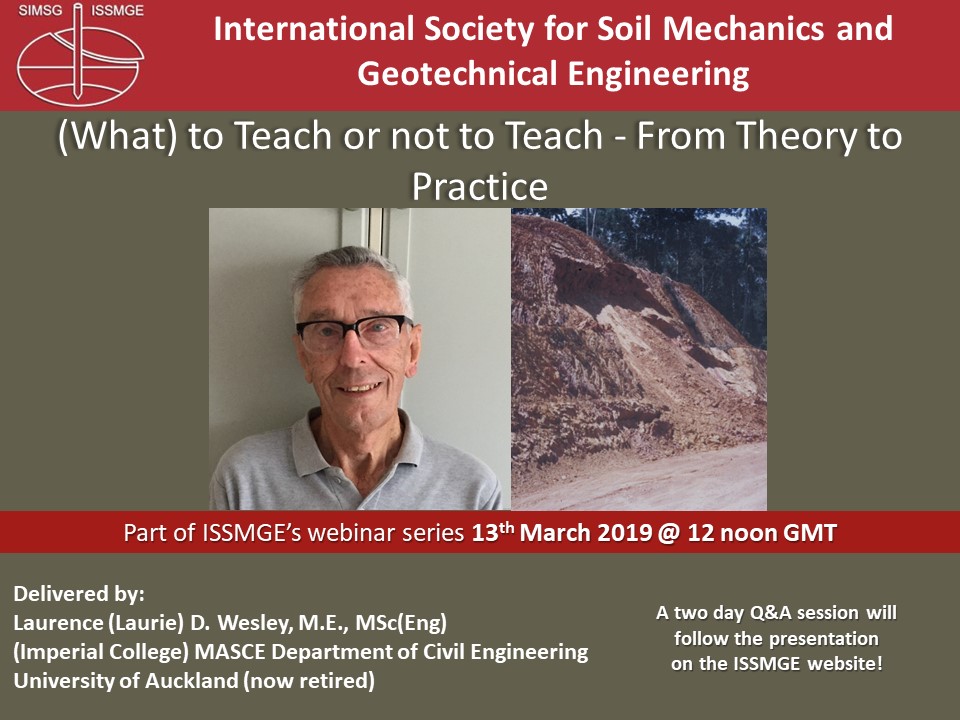![3rd John Burland Lecture | Changing attitudes, organization and scale in engineering education: The teacher as a go-between and TC306 as a knowledge broker {"category":"honour_lecture","subjects":["Education", "Teaching Geotechnics"],"number":"TC306-GEE2025-01","instructors":["Marina Pantazidou"]}](/asset-v1:ISSMGE+TC306-GEE2025-01+2025+type@asset+block@pantazidou.png)
- ISSMGE
- {"category":"honour_lecture","subjects":["Education", "Teaching Geotechnics"],"number":"TC306-GEE2025-01","instructors":["Marina Pantazidou"]}
- Starts:

This course includes two lectures, by John Atkinson (UK) and Lawrence Wesley (New Zealand), one case-study webinar by Carlo Viggiani (Italy), and one modular educational video by Marina Pantazidou (Greece). The titles and the summaries are as follows:
Basic Geotechnical Engineering Skills - What Can Graduates Do?, by John Atkinson (40 min)
As young people pass from school to industry through university, they acquire a set of skills. Their future employers in the construction industry need to know not what topics they studied but what they can actually do. Graduates from first degree courses, typically 4 to 5 years duration, should be able to design safe and serviceable slopes and foundations given some basic information on the ground conditions. They should be able to interpret a geological map and estimate reasonable values for soil and rock strength and stiffness from basic descriptions and hand samples and so create a reasonable geotechnical ground model. They should be able to distinguish between drained and undrained loadings and correctly select total or effective stress parameters and analyses. The lecture sets out a basic set of tasks that a graduate should be able to do. These can be tested: a graduate either can do these tasks or cannot do them. Some employers might expect them to do more but if they cannot do these simple tasks they will not be able to do anything else reliably. This Webinar was given as the 1st John Burland Honour Lecture to a meeting of TC306 in Belo Horizonte, Brazil on 20th October 2016.
(What) to Teach or not to Teach – From Theory to Practice (Part 1) & Compression and Consolidation Behaviour (Part 2), by Lawrence Wesley (130 min)
The difference between soil mechanics and geotechnical engineering is emphasised; the former is a theoretical discipline, the latter a profession, based on soil mechanics, but embracing geology, judgment and field experience. The teaching of soil mechanics is the focus of both parts of the webinar. Part 1 begins with recommendations regarding the order in which material should be taught, notably that the first lecture be on the principle of effective stress. Issues of terminology are addressed as well as the choice of a total or effective stress analysis. The pore pressure and seepage state in the ground are covered in detail, with special attention to the negative pore pressures above the water table. Part 2 begins with detailed coverage or the compression and consolidation behaviour of soils; in particular it shows that the e-log(p) graph gives a very distorted picture of compressibility, and only a linear scale gives a true picture of compressibility. A warning is given regarding the determination of cv from oedometer tests and the use of 1-D consolidation theory for estimating foundation settlement. Finally, a warning is given about the limits of soil mechanics theory, in particular for estimating safe heights of vertical cuts in clay or the estimation of bearing capacity of soft clay. The conclusion summarizes helpful recommendations for undergraduates to supplement the theoretical foundation of their subject with direct experience and observation in the field.
Porto Tolle test embankment - A full scale experiment on the consolidation of a thick clay layer, by Carlo Viggiani (24 min)
This case-study webinar deals with the consolidation process in fine-grained soils associated with the realisation of a well-monitored test embankment. The case study was developed specifically to be used by geotechnical instructors of engineering undergraduate courses as supplementary educational material for their students, through a collaborative effort of the presenter of the webinar (Carlo Viggiani) and the producer of the webinar (Michele Calvello).
What happens when soil compresses, by Marina Pantazidou (56 min)
This is an educational video for undergraduate students that uses the following best instructional practices: (1) The video is segmented in three short-duration subsections, each with a descriptive title. (2) Subsections are accompanied with quizzes of multiple-choice questions. [NOTE: Quizzes are visible only in the “Enroll” mode, not in the “View” mode.] (3) The presentation slides and transcript are available for download. (4) The transcript appears as text to the side and below the presentation slides. Subsection 1 considers as an example of compression the settlement of a building and introduces the main “actors” of soil compression (soil grains, soil pores, soil skeleton), as well as the quantities necessary for quantifying settlement (weight, load, pressure, stress). Subsection 2 deals with pumping water, because pumping also causes settlements. Finally, subsection 3 explains how can Soil Mechanics predict quantitatively the settlement of soil and gives some theoretical and historical background.
![3rd John Burland Lecture | Changing attitudes, organization and scale in engineering education: The teacher as a go-between and TC306 as a knowledge broker {"category":"honour_lecture","subjects":["Education", "Teaching Geotechnics"],"number":"TC306-GEE2025-01","instructors":["Marina Pantazidou"]}](/asset-v1:ISSMGE+TC306-GEE2025-01+2025+type@asset+block@pantazidou.png)
![Teaching numerical methods or teaching with numerical methods? {"category":"talk","subjects":["Numerical Analysis", "Teaching Geotechnics"],"number":"TC306-GEE2025-03","instructors":["Francesca Ceccato"]}](/asset-v1:ISSMGE+TC306-GEE2025-03+2025+type@asset+block@ceccato.png)
![Undergraduate teaching of Unsaturated Soil Mechanics: Building on fundamental physical mechanisms to pave the way for geotechnical analyses {"category":"talk","subjects":["Teaching Geotechnics", "Soil Mechanics"],"number":"TC306-GEE2025-05","instructors":["Alessandro Tarantino", "Alessia Amabile"]}](/asset-v1:ISSMGE+TC306-GEE2025-05+2025+type@asset+block@tarantino-amabile.png)
![Geosynthetics in the Classroom: Educating Future Engineers and Their Instructors {"category":"honour_lecture","subjects":["Education", "Teaching Geotechnics"],"number":"TC306-GEE2025-07","instructors":["Jorge G. Zornberg"]}](/asset-v1:ISSMGE+TC306-GEE2025-07+2025+type@asset+block@zornberg.png)